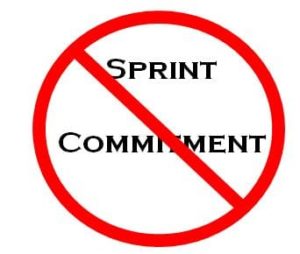 There is a lot of debate about Sprint Commitments in Scrum. In my mind, the notion of a Sprint Commitment is an anti-pattern. Of course, personal commitment is critical.
There is a lot of debate about Sprint Commitments in Scrum. In my mind, the notion of a Sprint Commitment is an anti-pattern. Of course, personal commitment is critical.
Every System has a Natural Velocity
Have you ever played or watched Deming’s Red Bead simulation? If not, watch video below. It’s pretty funny and a must-watch for anyone managing or coaching teams.
There is Variation in Knowledge Work
It is generally accepted that knowledge work has high variation – say in contrast to manufacturing. Scrum is used in situations where there is imperfect knowledge about the work to be performed. A common practice such as user stories that follow the CCC (Card, Conversation, Confirmation) pattern implies that there is room to explore the definition of a story. As such, there will be variation in how long it takes to complete work.
Sometimes there are Emergencies
Yes. Believe it or not, some Scrum teams operate in the real world where there are emergencies. Sometimes these are personal in nature and sometimes these stem from production support situations that get out of hand. There is a great post by Serge Beaumont on dealing with emergencies that talks about the alternatives for handling them. Serge argues that predictability is not the end goal of Agile – delivering valuable software is. Fixing a critical production issue will generally have higher ROI than working on a feature for an upcoming release. Sure we want teams to get better at reducing production defects (failure demand), but this takes sustained investment in time and energy.
Making Commitments Leads to Undesirable Behaviours
- Teams cutting quality to make the commitment.
- Working overtime to deliver but causing longer-term harm due to disengagement or dissatisfaction. This will also lead to teams under-committing in the future.
- Dropping “soft” scope items that really need to be there but will impair the customer experience.
Maybe XP has one solution to this problem. Always under-promise. Always hit the commitment. Use the slack time for important, non-urgent activities so that your team goes faster over time.
Why am I talking about this now?
This topic has been on my list of things to blog about for almost a year. I am writing about it now because Ken Schwaber and Jeff Sutherland updated the Scrum Guide and included dropping Sprint commitments as one of the significant changes. Other Perspectives: Xavier Quesada Allue calls for “soft commitments” (but stops short of calling commitments an anti-pattern – from two years ago)
Great video explaining Push vs. Pull
The video below provides a great explanation of push and it’s consequences as well as the benefits of pull.
Use Commitment for vision and values
Commitment in a healthy team or company is about doing our best each and every day in pursuit of our shared compelling vision. It is about demonstrating and following our shared values and working agreements. It is about kindly challenging others when they stray. For me, this is more about a sense of personal responsibility and accountability along the lines of Christopher Avery’s work. @tumma72 – ” I like to let commitment emerge from honor and respect in the teams I coach 😉 behavior vs words” @dneighbours – “personally I believe shared commitment is 100% necessary for high performance..”


